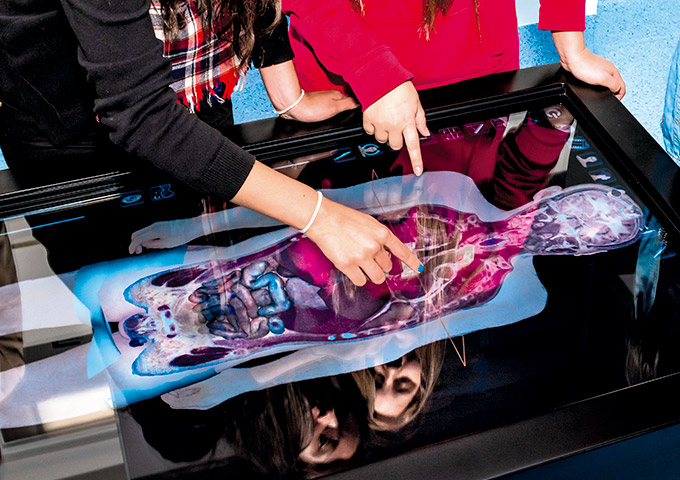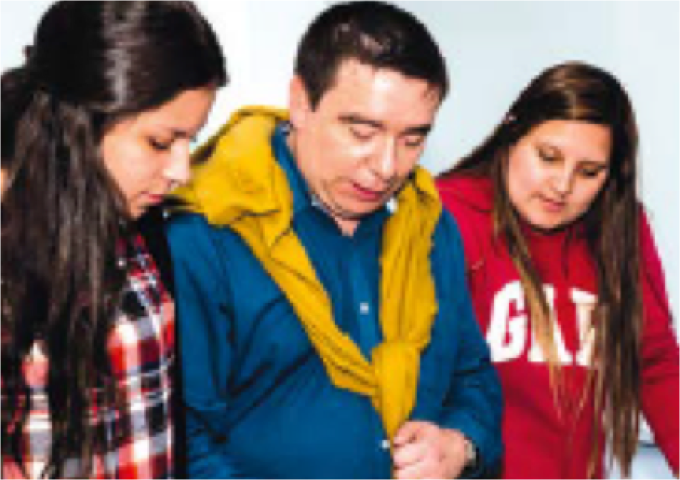With a virtual reality video game, anatomy can be learned in universidad del rosario
By: Marisol Ortega Guerrero
Photos:
Science and Tech

By: Marisol Ortega Guerrero
Photos:
Imagine you can shrink and enter the main artery, the aorta, and as if you were in a ship, you can perform a complete tour through the anatomy, scrolling through the blood conduits, uncovering every millimeter of the wonder that is the body. To add more excitement to the challenge, now you must choose the correct path among 116 options to reach the mammary gland and “attack” the cancer that has affected one quadrant or “destroy” the metastasis that took part of the armpit. You can help yourself with the laser that destroys the tumor cells that move in a way to similar to that of the Martians in a famous video game.
This innovative experience is not a dream but a reality at the School of Medicine and Health Sciences of Universidad del Rosario, specifically in the Anatomy class, and it is part of a process of teaching transformation. In this, the virtual reality (VR) video game Nanosurgeons Mammary Gland, which allows students to delve into the human body, plays an important role in the following: Obtaining valuable and unforgettable knowledge and finally being evaluated.
It all started three years ago, when low interest in the subject was detected, the magisterial classes discouraged them, and therefore, they did not learn. “We started to do a series of changes and analyzed whether to address the issue from a perspective closer to them, such as from video games, VR, and augmented reality, which would be a good mechanism to get them closer to anatomy, and they would be happier studying it,” explains Professor Ricardo Miguel Luque Bernal, medical surgeon, with a master's degree in genetics and expertise in embryology, bioethics, and anatomy, an area that he has been teaching for 13 years.
In the search, the professor and other colleagues observed that few pedagogical strategies in anatomy had VR as their base and that, there, they visualized a great opportunity. “We proposed the University to make a video game, and it was very responsive. It helped us in the development of the software, purchased VR glasses, and made everything easier for us. I think this would not have been possible in any other institution,” explains Professor Luque.
Everything coincided with a series of changes within the way of teaching in the institution; one of the innovation topics was hemato-oncology. There was a one-hour class on “mammary gland anatomy,” and they chose it as a possible nucleus for developing the video game.
The next thing was to analyze what they wanted to teach and how to apply the subject. Again, a light went on. The inspiration was taken from movies from the eighties, nineties, and earlier, such as Innerspace, 1987, and Fantastic Voyage, 1966, which had characters that shrank and entered the body. Pure science fiction. From there, the idea of “injecting” students into the first world of the video game, particularly to the aorta, the body’s main artery, to begin the mission of reaching the place where the tumor was, a task that refers to a clinical case assigned, which was none other than the tumor in one quadrant of the mammary gland.
Reaching the goal implies that students know all of the vascular structure of the upper body and dominate the field of arteries; that way, upon arrival at an intersection, they can choose the one they consider correct, among other alternatives.
A second “world” is related to the mammary gland: Students should know and “go through” each of its layers to be able to fulfill their goal. “We had to design a series of routes for the eight quadrants of the mammary glands; we achieved 116 possible paths, only eight of which are valid, specifically one for each clinical case that may occur,” explains the specialist.
Another playful component is the appearance of some Martians that represent the tumor cells, which implies that they have to know how to deal with them and then with the tumor itself. And only with students’ knowledge, which allows them to respond positively to some questions about mammary gland anatomy, and they go gaining ammunition to attack.
If they overcome this difficulty, they destroy the tumor, but the game tells them that they have a third “world” because there was metastasis; then, they have to reach the armpit, locate the axillary nodes where is located, and end it.
The idea is not to leave any loose ends or no subject to chance; therefore, the evaluation of students is not done the first time they enter the video game, which would be demotivating if they did not pass, but they are given the possibility of practicing as many times as they considered, without “losing lives.” When they have to be evaluated, they have three “lives,” as is usual in video games, and they have a limited time of 8–10 minutes. That is to say, they can select two game modes: Unlimited practice of lives or time, or evaluation and activation of a timer and a number of “bullets,” saving the result.
To help them throughout the process, they have a “virtual professor,” who serves as a guide, appears as a hologram in the ship, and is in charge of assigning them their mission and providing them with other specific guidelines. For example, when they make a mistake, the professor will indicate them that something is not right or will take them back to their last correct decision.

"We started to do a series of changes and analyzed whether to address the issue from a perspective closer to them, like from video games, VR, and augmented reality, which would be a good mechanism to get them closer to anatomy, and they would be happier studying it,” explains Professor Ricardo Miguel Luque Bernal, from the School of Medicine and Health Sciences.
In February of this year, the project leaders (Ricardo Miguel Luque Bernal, medical surgeon; Marcela Bogoya, systems engineer; and Angie Villamil, doctor, from Universidad del Rosario) did the test with premedical students, and the initial balance was very positive. The video game not only called students’ attention but also motivated them to learn about anatomy.
They have also worked in the training of professors and administrators in the use of software and hardware, both of the VR game and its administrative portal (it keeps track of the use), and in all authentication steps of the users, among other typical issues of this type of initiative.
For a quantitative approximation, the game matrix shows the number of times a registered student approached the video game and requested the glasses to use it, where did they go wrong, whether they are learning, whether there is a positive curve in the learning process, whether their knowledge has been strengthened, and whether there is greater motivation.
Now, the purpose is to carry out a second phase to interview students who wish to participate voluntarily; see how their perception of the video game is; whether they liked it; what they did not like; what they would change; and how they process the teaching.
While the general implementation was scheduled for April, due to the COVID-19 pandemic, this process had to be postponed. Researchers have taken advantage of this time to analyze how to design more video games that allow teaching other anatomy parts and work on the sketches and drawings of a second project. They want to go even further and make this innovative proposal cover other areas of medicine, such as physiology, pathology, and pharmacology, to make it more inclusive.
Breaking with the traditional schemes of teaching anatomy is the goal of Doctors Ricardo Miguel Luque Bernal, medical surgeon; Marcela Bogoya, systems engineer; and Angie Villamil, doctor, of Universidad del Rosario. To this end, they designed a VR video game, the first phase of which was completed in February this year. The project includes the video game called Nanosurgeons Mammary Gland, with an instructional video, a user authentication process, and a starting system, either in practice mode or in evaluation mode.
Level 1. Students are inside a ship that is the size of white blood cells and lipids. The exterior of the ship allows them to observe how it travels through blood vessels. As the ship advances, the ramifications of the circulatory system will appear, and they will have to take the correct routes, overcoming various obstacles.
Level 2. They must direct their ship to the adipose tissue to pierce with their laser each of the layers of the mammary gland, which is provided with “rooms” or “sections” into which they must enter in search of cancer cells to destroy them, facing the encumbrances that appear on the way. As they progress in the layers, they will have a map next to them, where they can see how deep it is in the breast.
Level 3. When everything seems to be over, the tutor or virtual professor warns them that there is an SOS because the cancer has metastasized, so they must start the journey toward it, defend themselves, and attack when they feel threatened, until finding it in the armpit, destroying it, and finishing the game successfully. To get to the armpit and to search through the ganglion groups, they must choose between various “portals” that lead them to specific places, analyzing each step indicated by the virtual professor.